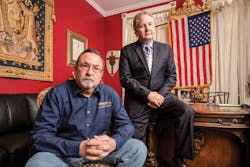Stacie Deblieux has never worked in a body shop. Before that day, she’d never stepped foot in one.
But, on the shop floor of a Louisiana repair facility last spring, it didn’t take long for Deblieux to grasp the severity of the issue.
The shop owner held up two aluminum wheels for Deblieux and the rest of her team from the Louisiana attorney general’s office. They looked almost identical, indistinguishable to a “layperson,” Deblieux says; at least, until the shop owner asked her to pick them up, one at a time.
One was noticeably lighter—more than two pounds lighter, the shop owner explained.
“And he said that the lighter wheel was the one he was being required by the insurance company to put on the vehicle being repaired; the heavier one was the OEM-required part,” she says. “It wasn’t even close, and what effect is that going to have on the vehicle after the repair is complete?”
“It doesn’t take an expert to understand what we saw,” she adds. “The wheels looked no different. A consumer would never know the difference. Yet, the consequences could be severe.”
Deblieux, the assistant attorney general of Louisiana, is one of the lead attorneys behind her office’s suit filed against State Farm Insurance in August, alleging that the insurer has used business practices aimed at controlling the industry and forcing unsafe repairs on vehicles without the knowledge of the consumer.
Lawsuits against insurance providers are nothing new to the collision repair industry. They’ve been going on for decades. But Deblieux and her team’s litigation represent a potentially ground-breaking shift in the perpetual insurer-repairer squabble. That difference lies with Deblieux’s newbie status to the industry: She’s a consumer, and her office represents the consumer with the power of consumer-protection laws standing behind them.
The fight is no longer relegated to a handful of shops haggling with insurers over dollars and cents in court, says Mississippi-based attorney John Eaves Jr. It’s about common-sense safety for consumers; it’s becoming a consumer issue.
It’s why Eaves agreed to lead a much-publicized, ongoing, multidistrict case in U.S. District Court in Florida against a slew of insurers on behalf of repairers. It’s why Eaves and a team of shop owners and attorneys are working with U.S. Congressmen and women to pass new legislation to reinforce standards many believe should’ve been upheld long ago.
And it’s why many around the industry feel a wave of change coming in 2015. One shop owner referred to it as a “revolution.” Another called it “a last stand” for independent shops. Many more say it will change the industry forever.
Hyperbole aside, Eaves, a relative industry newcomer himself, says this could be a turning point for collision repair facilities with widespread ramifications throughout the industry.
The Golden Age of the DRP, Part I
It’s no secret that insurer direct-repair programs (DRPs) have grown substantially over the past 15 years. Numerous reports from around the year 2000 estimated that the overall percentage of sales from DRPs hovered somewhere between 20–30 percent, depending on the source.
According to FenderBender’s 2014 KPI Survey—completed by 573 collision shop owners and managers throughout the country—roughly 70 percent generate some portion of their revenue through DRPs; about 50 percent of shops said they generate 30 percent or more of their revenue from them.
Bob Passmore, a spokesman for the Property Casualty Insurers Association of America (PCI), says that DRPs are aimed to be “mutually beneficial,” helping shops work more efficiently and saving money for all three parties involved—the shop, the insurer, and the vehicle owner.
Data from the KPI Survey backs up that claim. Fifty-four percent of all respondents claimed to have a cycle time of seven days or less. That’s compared to 40.5 percent shops without any DRP work. More than 54 percent of shops that receive 1–29 percent of their revenue from DRPs have cycle times at or below seven days, and the trend improves as the percentage of DRP-generated revenue increases; 76 percent of shops that receive 90 percent of their revenue from DRPs have seven-day-or-better cycle times.
“A vibrant, profitable auto collision repair industry is in the interest of State Farm and other auto insurers,” says State Farm’s Dick Luedke. “We believe repairer profitability and quality auto repairs that are reasonably priced can both be achieved.”
And many large multiple-shop operations (MSOs) see DRPs as a strong revenue-generator. FenderBender data showed a strong link between shop size (both in revenue and number of locations) and involvement in DRPs. MAACO’s vice president of fleet operations, Frank Petrane, says that insurance work is one of the company’s three foundational customer-generators (along with fleet and retail sales). And CARSTAR’s senior vice president of insurer relations, Dan Young, told FenderBender in September that having strong ties with insurance carriers is a key to thriving in today’s market.
The Golden Age of the DRP, Part II
Still, the nation’s largest MSOs have less than 1,000 shops combined in the U.S., less than 3 percent of the overall industry. Many independent shops and smaller MSOs say DRPs are squeezing profits and, in some cases, forcing repairers to make decisions to “blur the lines” on what constitutes a safe repair, says John Mosley, owner of the two-location, $8 million-a-year Clinton Auto Body in Mississippi.
Mosley was one of three founding plaintiffs in Eaves’ case, along with fellow Mississippians Bill Fowler of Bill Fowler’s Bodyworks and Doug White of Capitol Body Shop. When Mosley, Fowler and White first met with Eaves, they showed a track record of roughly 3,500 repairs between their three shops and an average of $675 in short pays.
PCI’s Passmore says these issues do exist in the industry.
“Since there are lawsuits out there about them, they are issues [that exist],” he says. “Just for that fact alone, it’s impossible to deny.”
In her investigative visits for the attorney general’s office to dozens of repair shops across Louisiana, Deblieux witnessed firsthand the amount of “cutting corners going on out there.” It violates consumer protection laws, she says, and the charges of insurer steering go against the Sherman Anti-Trust Act, promoting fair trade.
“The direct repair programs are tools that make unscrupulous behavior easier to perpetuate,” Deblieux says. “They keep consumers in the dark. The repair process is completed between the body shop and insurance company.
“I wouldn’t say it’s illegal, necessarily, but it’s part of a bigger environment where we have unlawful action taking place right now.”
And, Deblieux says, these are actions insurers agreed to avoid more than 50 years ago through the 1963 Consent Decree—the document that serves as the foundation of both Deblieux’s and Eaves’ lawsuits, as well as the draft legislation Eaves and his team have proposed to lawmakers in Washington D.C.
Do DRPs Help Cycle Time?
Direct repair requirements aim to help shop efficiency—decreasing wasted time, wasted materials, and cycle time. But how does that play out in real-world shops?
According to the shops that responded to FenderBender’s 2014 KPI Survey, shops with DRPs had substantially better key-to-key cycle time than those that didn’t. And shops that generated no revenue from DRPs performed worse than the overall industry average.
An Outcry for the ‘Decree’
The 1963 Consent Decree is not a law. By definition a decree of consent is a written agreement or settlement to resolve a dispute between two parties without an admission of guilt. There is no court review, and it does not set any legal precedent. Think of it more like a contract between two parties, Deblieux says.
The 1963 decree came after an investigation by the U.S. Department of Justice and then U.S. Attorney General Robert F. Kennedy, looking into alleged wrongful insurance practices. The defendants in the case were three insurance trade associations (now defunct) that represented 255 insurance carrier members.
The results, outlined in the document, prohibited, among other things, any of the defendants “from placing into effect any plan, program or practice … directing, advising or otherwise suggesting that any person or firm do business or refuse to do business with … any independent or dealer franchised automotive repair shop with respect to the repair of damage to automobile vehicles.” It also specifically speaks against setting prevailing rates for repairs or labor, and influencing the way shops do business.
Although the 1963 Consent Decree is not U.S. law, it is still in effect today, and Deblieux says it’s clear that insurers are in violation. DRPs, in general, go against the very fabric of this agreement, she says.
Eaves agrees. The suit in Florida seeks punitive damages for the shops serving as defendants on the basis of these requirements, and insurers knowingly violated them. The draft legislation the industry is pushing aims to make the decree an official law.
If Deblieux or Eaves succeed, the results could be monumental for the industry, they say. It could mean the end of the DRP.
‘Time to do What’s Right’
Mosley laughs at the way he’s often painted by many in the industry. “Insurance adversary” is often the term, he says.
He doesn’t see it that way. In fact, his shop still has one DRP from Alfa Insurance, as they’re “fair and don’t intrude on my business,” he says.
“I come from a family of sharecroppers, and my dad was a Marine, and my parents always raised us to believe that you only do things for the right reasons,” Mosley says. “This entire thing isn’t about getting money from insurers. … We’re doing this because it’s the right thing to do, and it’s time to do what’s right.
“Our job is to do what’s right by the consumer, and if we can get them to see that, and get them to understand that we’re fighting for them, they’ll stand behind us.”
That’s certainly Deblieux’s hope. Her office is focused on raising awareness, much more than the actual results of the suit. An informed consumer is the best option for all parties, she says.
Eaves has shops in more than 40 states involved in the case today, and a trial date expected to be set during a mid-December hearing. Currently, the suit is in its discovery phase, in which insurers will be forced to turn over sensitive internal documents.
Eaves wants an expedited trial. He doesn’t want to settle. He aims to win.
“Absolutely,” says Eaves, who is known for high-profile cases, including one following the disaster with the Italian cruise ship Costa Concordia. “Our firm is dedicated to the preservation of life. We felt that if we didn’t take this case, there would be lives lost due to these unsafe repairs forced on shops.”
Eaves wants a precedent set in accordance with an updated version of the 1963 Consent Decree, and he believes DRPs will be banned.
Passmore says the insurance industry seems to be shrugging off the recent allegations as “more of the same.” Though not privy to any intimate details of the most recent cases (“I know as much as [the public] does about the specifics of it,” he says), Passmore noted that "the relationship between insurers and body shops has always been a little bit adversarial."
Passmore suggests both industries find a way to better co-exist, as they serve the same customer; squabbling only hurts those vehicle owners.
With this wave of legal action moving forward, Deblieux says, consumer awareness will rise regarding these issues. That is the key to any change moving forward in 2015. For any of these actions to be successful, Deblieux says more consumers need to have their “wake-up” moments like she had standing in that Lousiana shop last spring.
“There could be widespread changes,” she says. “This is a consumer issue, and we’re looking for consumer relief.
“When the average person is in a collision, they aren’t educated on all the workings of the industry. It’s a difficult, emotional thing, and they can be taken advantage of very easily. It’s our responsibility to do something to protect them.”





